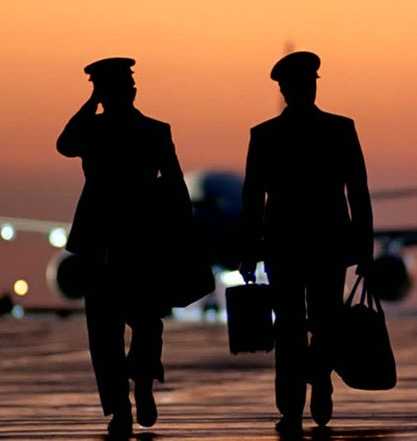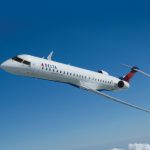Why Alaska Airlines Pilots Are Voting on a Strike
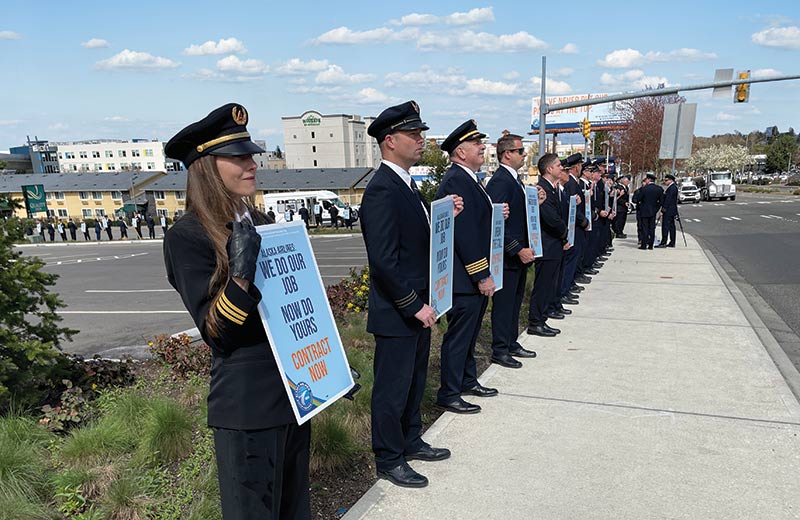
The woes of Alaska Airline’s operational challenges and the contentious bargaining between Alaska management and the pilot group has been prominent in the news. Especially as the pilots are now voting to strike. The recent challenges do not directly stem from the bargaining issues but are partially related.
This article will explore the roadmap of how the situation at Alaska Airlines has emerged and what the outcome could look like.
Roadmap of Current Contract Negotiations
The Air Line Pilots Association Master Executive Council (MEC) and Alaska Airlines management began negotiating on the collective bargaining agreement in spring of 2019. This was ahead of the agreement’s amendable date in the spring of 2020.
With the onset of the Covid pandemic in 2020 the two sides chose to focus on preventing involuntary furloughs. The ALPA MEC proposed alternatives to furloughs such as an extended incentive line (EIL) program, Retirement Extended Incentive Lines (REIL), Extended Leaves of Absences (ELOA), and the Early-Out Retirement Program. These programs prevented involuntary furloughs and in helped Alaska Airlines to respond to the travel recovery in a quicker and more efficient way than with furloughs.
Timeline since the bargaining talks have resumed:
- In spring of 2021 negotiations resumed on the collective bargaining agreement
- By the fall of that year it became clear that talks weren’t proceeding. The two sides attempted three days of talks using private mediators.
- After the mediated discussions didn’t work Alaska Airlines Management filed for assistance with the National Mediation Board (NMB).
- In December of 2021 the two parties met for initial sessions with the NMB’s mediator with the talks continuing into early 2022.
Current Stalemate
Alaska Airlines pilots and management have not been able to come to an agreement, with two primary sticking points for the pilots:
- Scope protection, which spells out who may fly airplanes on behalf of the airline and in what circumstances that work may be outsourced.
- Scheduling improvements for pilots
Alaska Airlines Pilot’s Position
Terms of negotiation typically remain confidential. However, some parts have been made publicly available. Proposals from Pilot’s include:
Proposed Scope Protection
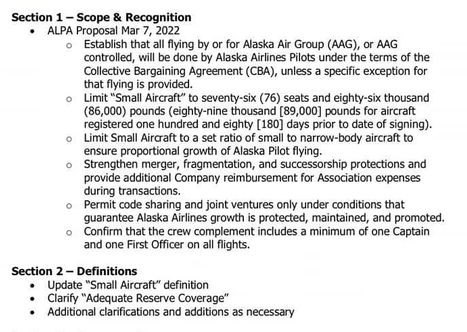
Proposed Pay Rates
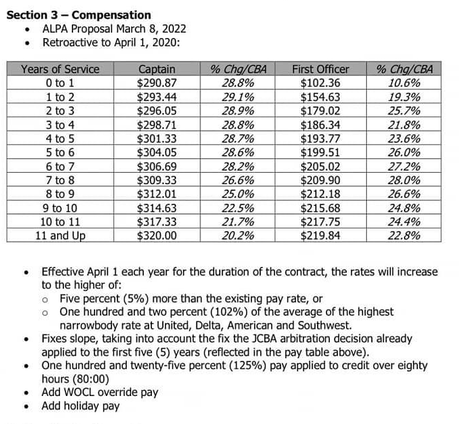
It is important to realize that pilot pay rates do not directly correspond to traditional hourly pay rates. Pilots earn hours differently. A direct hour to hour rate comparison is not appropriate.
Alaska Airlines Management Position
In a press release, Alaska Management stated:
“ALPA’s proposals to date would burden Alaska Airlines with the highest-cost pilot contract in the industry by a significant margin. That simply doesn’t work for our customers, employees and shareholders.”
The company states about their proposal to the pilots:
- “The company’s wage proposal on signing would elevate top-of-scale Alaska Airlines captains and seven-year first officers to the third-highest pay rate in the industry (behind Southwest and American). The offer would also provide annual scale increases and a mechanism for additional annual increases if warranted by changes in market pay rates.”
- “At ALPA’s request, the company kept the incumbent retirement plans unchanged. Alaska Airlines’ counter-proposal on retirement would offer new- hire pilots participation in a 401(k) plan with a company contribution that exceeds what most other U.S. airlines offer. Closing the existing defined benefit plan to new pilots improves the long-term security of the pension fund for current participants.”
- “The company’s counter-proposal on insurance would slightly increase pilots’ monthly contribution, but would provide them with expanded dental and vision benefits; improved short-term disability, life, and accidental death and dismemberment insurance; eliminate the prescription drug deductible; and add a cap on annual increases in employee contributions.”
- “The Alaska Airlines counter-proposal does not propose any significant change over current language regarding code-share and contract flying.”
The press release continues “Changing industry economics may affect the company’s future proposals.”
What is Scope Protection?
Scope Clause is part of a collective bargaining agreement that limits the number and size of aircraft that may be flown by the the airline’s regional airline partners. In some circumstances it limits codesharing or other agreements with other airlines.
These agreements primarily exist in the United State, Canada, and Mexico and are important to pilots in preventing jobs in migrating from higher-paid major airlines to lower-paid regional airlines. This has occurred in the past. Frontline created an episode when this outsourcing was more prevalent – Flying Cheap.
This video provides an overview of scope protections. There is an inaccuracy in the video. The creator states that most regional airlines are not unionized pilot groups. Whereas most regional airline pilot groups in the United States are represented by unions.
Existing Scope Protection at Legacy Airlines
The following table details what flying may be outsourced to regional airline partners for each of the Legacy Airlines in the United States. Most of the limits are based on passenger seating capacity of airplanes being used in outsourced flying.
| Airline | Up to 50 Seats | 51 to 76 Seats | Notes |
|---|---|---|---|
| American Airlines | No Limit | Above 65 seats, regional airlines may not exceed 40% of the mainline narrow-body fleet | Regional flying between specific cities listed in contract may not exceed 1.25 percent of mainline block hours |
| Delta Air Lines | Up to 348 Airplanes | Up to 102 airplanes with 70 seats, up to 153 airplanes with 76 seats | 85% of flying to be less than 900 miles, 90% of flying will be to and from hubs |
| United Airlines | Up to 90% of the United Airlines narrow-body fleet | 255 airplanes between 51-76 seats, not to exceed 153 airplanes with 76 seats | Regional block hours must be less than mainline block hours. Mainline routes flown in last 24 months prohibited unless United could not earn an adequate return. |
| Alaska Airlines | No Limit | No limit | No Scope Protection |
| Hawaiian Airlines | Cannot be flown on trunk routes serviced by mainline aircraft | Not Applicable | Not Applicable |
Alaska Airlines Pilots Scheduling
The Alaska Airlines Pilots have created a video showcasing their position on scheduling.
Alaska Airlines Operational Challenges
Alaska Airlines has been contending with operational challenges and has had to cancel flights in response. In a press release responding to the cancellations Alaska Airlines stated:
“Simply put, we had 63 fewer pilots than what we planned for when we built our schedule. By the time we caught this error, April and May schedules were bid on by our pilots and flight attendants, making it impossible to sufficiently adjust schedules to avoid cancellations.”
The union has countered Alaska management’s position “Attrition is such that the airline is wasting nearly half its training capacity training replacement pilots. During exit interviews, time and time again pilots are leaving to other carriers for better quality of life.”
The union said “last year’s record-setting pilot-resignations were surpassed in March. Alaska Airlines is on track to lose 180 pilots this year, not including retirements.”
Pilots Conduct Informational Picketing
On April 1, 1,500 pilots from Alaska Airlines and pilots from other airlines conducted informational picketing at airports in Alaska’s system.
This picketing was conducted by pilots that were not scheduled to work. It was not a work slow down activity and did not cause flight cancellations.
What Happens if the Pilots Vote to Strike
Relations between airlines and the airline labor groups is governed by the Railway Labor Act (RLA) in order “to avoid any interruption of interstate commerce by providing for the prompt disposition of disputes between carriers and their employees and to protect the right of employees to organize and bargain collectively.”
The RLA provides mandated dispute resolution procedures with the intention to settle disputes via a grievance structure and postpones the ability of either party to take action in bargaining disputes without first completing the process as outlined in the RLA.
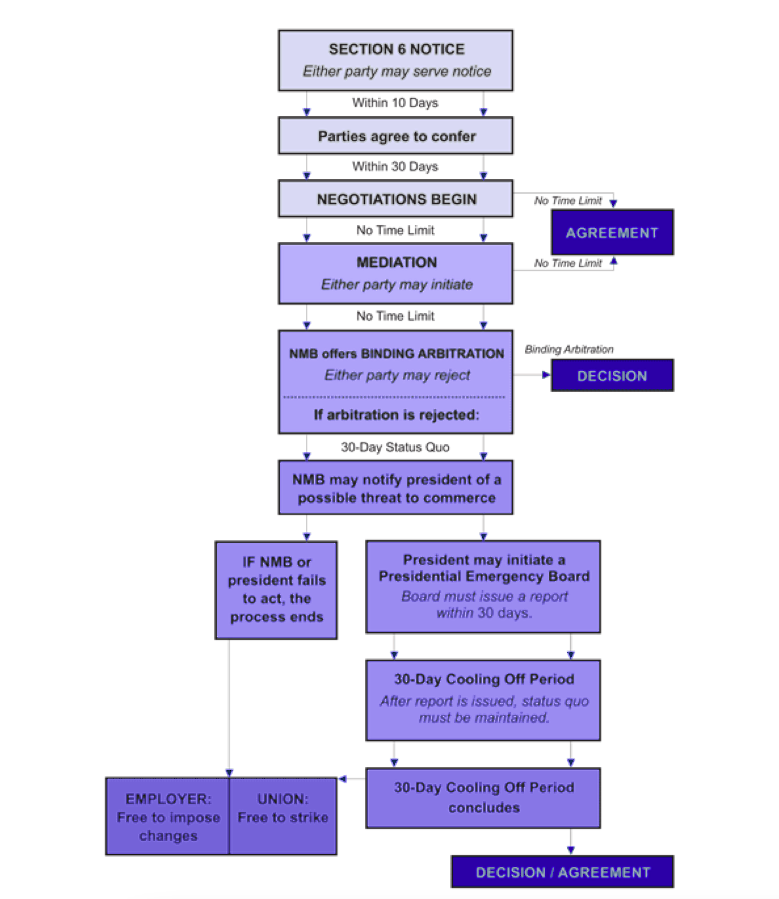
If the pilots vote to strike both parties may avail themselves of national medication board mediation or arbitration services. If both parties do not agree to this they will be released for a 30-day cooling off period. During the cooling off period no work actions make take place. After the cooling off period both parties are released to self help. During self help existing agreements do not remain in place. The company may lock employees out of the workplace and/or the employees may strike.
The federal executive branch may intervene and force the pilots back to work. This was done most recently in 1997 by president Clinton.
- Use of featured image provided by Air Lines Pilots Association
Greg started his professional pilot journey in 2002 after graduating from Embry Riddle. Since that time he has accumulated over 8,000 hours working as a pilot. Greg’s professional experience includes flight instructing, animal tracking, backcountry flying, forest firefighting, passenger charter, part 135 cargo, flying for a regional airline, a national low cost airline, a legacy airline, and also working as a manager in charge of Part 135 and Part 121 training programs.

